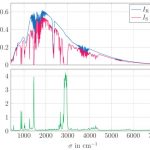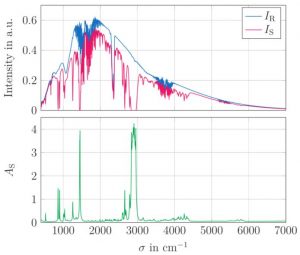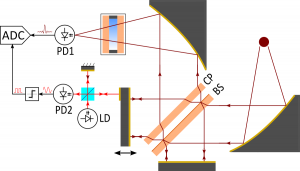
MobileSpectro
Development of a high precision handheld FTIR spectrometer for the mobile chemical analysis of fluids
Project goals
- Development of a handheld Fourier-transform infrared (FTIR) spectrometer
- Measurement and mobile analysis of samples in the condensed phase
- Miniaturization and ruggedization to bring high-performance spectroscopy to the field
Description
Infrared spectroscopy is considered to be a fundamental technique for the characterization and analysis of chemical compounds. As illustrated in Figure 1, measurement of the sample’s wavelength-dependent absorption, which is directly related to its molecular structure, enables the application of multivariate chemometric techniques for the elucidation of the contained chemical compounds.

Figure 1: Polychromatic light, emitted by a black-body radiator (Ir) is transmitted through a specimen and recorded by the spectrometer (Is). Knowledge of both quantities allows for the calculation of the sample’s absorptivity (As), which is indicative of its molecular structure.
In contrast to dispersive instruments, FTIR spectrometers typically use a scanning interferometer, such as shown in Figure 2, to record the transmitted intensity as a function of optical path difference (OPD). This offers not only the advantage of significantly increased signal-to-noise ratio and reduced measurement time, but also enables a broad spectral region (typically 650 cm-1 to 4000 cm-1) to be observed simultaneously and provides high wavenumber accuracy by using a reference laser for position measurement. Owing to the interferometric measurement principle, existing systems offer limited applicability to field usage scenarios due to their temperature and vibration sensitivity, as well as their limited signal-to-noise ratio. Currently available devices focus on attenuated total reflection (ATR) sampling methods, making them unsuitable for the analysis of liquid samples, especially for spectral resolutions better than 4 cm-1.

Figure 2: Typical FTIR spectrometer arrangement. Radiation from a source is collimated, passed through a Michelson interferometer and through the specimen, and focused on a detector (PD1). By scanning the position of one mirror, the intensity signal as a function of optical path difference is recorded. The Fourier transform of the spatially sampled interferogram corresponds to the source spectrum.
MobileSpectro aims to design a miniaturized FTIR spectrometer that enables handheld operation, is sufficiently robust for field use, offers a spectral resolution of better than 2cm-1, and has a signal-to-noise ratio that allows the application of advanced chemometric techniques. Based on highly-integrated mechatronic system components, novel opto-mechatronic assebmlies, advanced data processing and control algorithms, a highly robust device, tailored to the needs of future in-field spectroscopy, is developed.
Applications
- Predictive maintenance of heavy machinery
- Quality control in petrochemical, pharmaceutical, and cosmetical industries
- Detection and identification of unknown chemical agents
- Environmental pollution and contamination monitoring
Project partner
Funding
Contact
Associate Prof. Dipl.-Ing. Dr.techn. Ernst CsencsicsUniv.-Prof. Dipl.-Ing. Dr.sc.techn. Georg Schitter
Project Staff
Associate Prof. Dipl.-Ing. Dr.techn. Ernst CsencsicsDipl.-Ing. BSc. Johannes Wiesböck
Time
2022 - 2025Status
ongoingFurther Links
Grabner Instruments Messtechnik GmbH
Open Positions
The AMS group offers vacant positions at PhD and PostDoc level